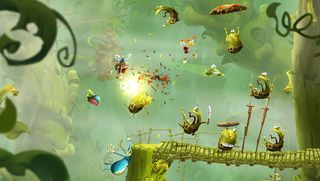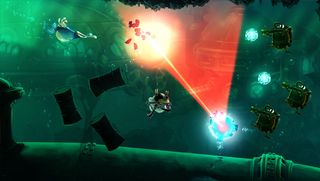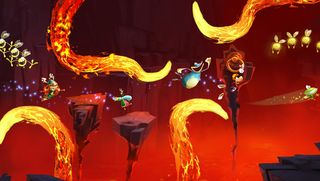Why Rayman Legends is a better Sonic and Mario game than Sonic and Mario
Giant slayer

Accepted gaming wisdom has always placed Mario and Sonic as the kings of platforming. Accepted gaming wisdom no longer holds true. While he was just another also-ran when he first appeared in '90s, another wannabe platforming mascot without the thrills or imagination to compete with old Red and Blue, Rayman is now--in many ways--mightier than either.
It's easy to imagine that Ubisoft's limbless hero limped away after his initial defeat, beaten but vowing to come back stronger. It's easy to imagine that he spent the intervening years watching and studying his Japanese cousins with obsessive attention to detail, learning what made them tick and what made them great, and deconstructing their strengths and weaknesses ready for the day that he would come back stronger than either, and use their own tricks against then. And now he has. Because Rayman Legends is incredible. Not only brilliant in its own right, it's a better Sonic and Mario than Sonic and Mario. Here's why.
It's precision engineered like few games out there

This is the first thing that will strike you about Rayman Legends. Like any truly great 2D platformer it thrives pixel-perfect jumping demands. And thats just the way it should be. To truly get the best out of the genres capabilities, a 2D platformer needs to be able to get extravagant with its design, exploring the full possibilities afforded by 2D level structure. To be able to do that, it needs to be able to put high demands on its player. And to do that, it has to control with total precision and be presented with utter clarity.
You see this property in all of the best Mario games, from the NES onwards. Sonic has always been pretty good for it too (in 2D at least), though not quite as polished as the plumber. And its the reason the likes of the Donkey Kong Country series have never quite made the A-list. With their broad-strokes platforming and fuzzy-edged, level architecture, they just cant accommodate the kind of stuff that makes the big guys great. Rayman however, nails it, miraculously blending anarchic, organic looks with utter platforming precision thanks to its painterly but razor sharp hand-drawn art style. And with the basics down, it then sets about combining and improving upon everything else that Sonic and Mario do well. For instance
It's effortlessly versatile

A classic Mario trope, this one, but one which the plumber has strayed away from slightly in recent years. One of the hallmarks of excellent game design--exemplifying a powerful grasp of both control mechanics and level design--is the ability to create endless new spins on the core gameplay without adding any conspicuous extra elements.
Its an oft-underrated ability, precisely because when its executed well, the end result is utterly seamless. But its an absolute art, requiring the development of deep, versatile core systems that play with instinctive simplicity, as well as an insightful eye for designing levels that draw that versatility out. Super Mario 3D Land throws out some excellent examples of this when you start playing through the hardcore level remixes of its Special Worlds, and New Super Mario Bros. U is a much deeper game that it at first appears, though its greater intricacies will be seen mainly by the more dedicated speed-runner. Rayman though, takes adaptability as a core tenet of its idea generation from the start.
The controls are solid but immensely 'bendable'

The reason Rayman is so versatile? Brilliantly nuanced controls. They seem like a stock platformer set-up on intial touch (walk, run, jump, float), but some practiced play reveals something more akin to the set-up of a good fighting game, with almost every action capable of adapting, cancelling or transforming the properties of Raymans movement in some way. Combining the precision after-touch of Mario, the bendable momentum physics of Sonic, and the subtle tweakability of Ryu or Chun-Li, theres a wealth of context-sensitive control mastery to be found underneath Raymans seemingly simple gameplay.
Sign up to the GamesRadar+ Newsletter
Weekly digests, tales from the communities you love, and more
A jumping attack can lead to triumphant, foe-demolishing rampage of glory in Raymans sprinting levels, but if you mess up your timing and momentum it can stall you (literally) dead. Though sometimes an improvised air-brake is exactly what you need. Wall-jumps are fairly straight-forward, but when you work out how to scamper up sheer surfaces, your traversal will get just that bit sharper. Some of the Invaded time-trial levels will seem physically impossible at first, but by seeing through the Matrix of level design and control hacks youll eventually smash them with seconds to spare. Mario and Sonic both provide deeper levels of control to the dedicated player, but not on this level.
Its basic core gameplay does EVERYTHING

Straight platforming levels. Speed-run obstacle courses. Vertical speed-run jungle gyms. Flying levels. Stealth levels. Swimming levels. Swimming stealth levels. Full-blown, bullet-hell shmup levels. Rayman throws out all of these as part of a continually evolving, constantly shuffling playlist of 2D gameplay greatness. And there's only one additional power-up in the whole game. Thats pretty amazing design right there.
The rest of the above is created using nothing but the games standard gameplay mechanics and some really creative level structure. Not only is that a Hell of an economical design feat, but it allows some really organic mix-and-match level design. You wont know what youre going to get from level to level, but you also wont know what youre going to get from second to second within a level. To blend platforming, flying, shooting and swimming in one stage, Mario would require some fairly segmented level design and a host of tactically placed power-ups and costumes, each of which would come with usage stipulations and restrictive requirements that Rayman just doesnt have.
It has a seriously confident difficulty curve

Mario and Sonic never used to shy away from a challenge in the old days. But both have softened up over the years. Where Mario games used to acclimatise the player during the first few levels and then steadily crank things up over the course of everything following, they now tend to save their hard stuff for their last sections, or an unlockable post-game area. Sonic games used to work similarly, but since going 3D their challenge has come more from Simon Says reaction tests and level memorisation than genuine gameplay complexity.
Rayman however, feels much more robust. This is a game confident in its core gameplay, and confident in its designers ability to experiment, expand, and escalate. Rayman knows that simply throwing in a boatload of ideas isnt enough. It knows that the best way to wring the most potential out of those ideas is by exploring them to the fullest. That means challenging the designer and challenging the player. Things rapidly get tough in Rayman Legends, but because that toughness comes entirely as a result of the game getting more creative and in-depth with its ideas, it never feels unfair or punishing. In fact it only ever gets more rewarding.
It's fast and demanding without being cheap

Think of Sonic the Hedgehog and you think of speed. If asked to come up with an iconic Sonic image, youll always think of him burning around the Green Hill Zone loop at 100 mph. What you wont think of--because nostalgia dictates that no-one ever does--is how goddamn tacky the early Sonic games could be with their speed. For every cathartic burst-run after a tricky platforming section, there was a cheesy enemy or spike-wall placed precisely in Sonics path to create cheap difficulty.
Rayman doesnt do that. While Legends is packed with breakneck, do-or-die sprints, it only ever uses its speed to excite, not bewilder. Obstacles are perfectly paced to provide exhilaration and ample reaction time. Rather than hindering, enemy placement is carefully designed to assist with showboating jump chains and hit combos. Rayman rewards skill and creativity where Sonic so often punishes daring. With his various chain-slides, rope-swings and wall-hops deliberate and controllable whatever the pace, Raymans high-speed handling is friendly and nuanced enough to cope with anything. Thus, Legends' spectacular takes on the time-trial concept make traversal not a frustrating reaction challenge, but a deep and rewarding environmental puzzle.
It's fast and exhilarating without being shallow

As sonic has got faster over the years, his gamplay has become more superficial. Its a trade-off between whizz-bang spectacle and interactivity. When the whizz-bang comes in the form of rattling through levels at speeds only Dishonoreds Corvo could properly process, youre inherently going to be looking at a game based on twitch reactions and QTEs. Thats modern, 3D Sonic right there. Glorified Temple Run at a thousand miles a second.
But Rayman doesnt take that route. Its careful pacing packs in a wealth of deep, multi-layered gameplay even when youre sprinting across (or up) a level without a second to spare. In fact, if anything, the faster sections present the more intensive, more cleverly intricate challenges, as well as some of the most creative deconstructions of Legends core gameplay. One of the early time-trials, for example, has you racing through a level defeating each enemy in the area to unlock stone barriers. You must constantly push forward, fully harnessing every bit of hidden momentum available while deciphering and maintaining the optimum route along one big comboed hit-chain. And thats in the first world.
It has more personality than any other platformer

Neither the Mario or Sonic series is devoid of character. The Mario series in particular is great at imbuing every element of a level with life, from hills that (literally) have eyes, to the hapless, bumbling malice of its Goombas and Koopa Troopas. And while Sonics world is a little more sterile, there are still plenty of character tropes to love (and hate). But Rayman trumps both of them for personality.
Its there in the confused, not-cut-out-for-the-job countenance of the Frog People, whose vacant, dazed stare always gives way to shocked surprise that half-second too late to react to attack. Its in the omnipresent musical skeletons, happily but lethally going about their business in the world based on the Mexican Day of the Dead. And it pours out of the multitudinous layers of parallax in the forest stages, filled as they are with half-told tales of secret civilisations and unfathomable monsters. For an unvoiced, 2D game, Rayman Legends has a damnably well-rounded world. When you have visual storytelling this good, who needs dialogue anyway?
A legendary victory?

So that's the full low-down on Rayman's epic return. Have you played Legends yet? Do you agree that the balance of platforming power has now shifted? Let us know your feelings in the comments.
And while you're here, why not check out some of our similarly analytical content? Maybe start with Lara Croft: Most real hero of current-gen, and then move onto Why The Last of Us is the first truly mature action game narrative.

Helldivers 2 dev asks players to stop deliberately shooting at soldiers with that sweet blue pre-order bonus armor that's apparently a yogurt salesman uniform

Stellar Blade release time – the countdown to the new PS5 action RPG is on

Wilson Fisk celebrates 60 years of Daredevil by reclaiming his mantle as the Kingpin
Most Popular



